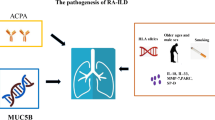Abstract
This paper aims to study the background and clinical characteristics of tacrolimus (TAC)-induced lung disease. A case of a rheumatoid arthritis (RA) patient who developed TAC-induced interstitial lung disease (TAC-ILD) is reported. The Japanese Pharmaceuticals and Medical Devices Agency (PMDA) website was searched for cases of TAC-ILD and its prevalence among all cases of TAC-related adverse events. As for cases of TAC-ILD, its underlying disease, preexisting lung diseases, and fatal outcome were also searched. Literature review of TAC-ILD cases was added. A 65-year-old female RA patient with preexisting bronchiectasis developed near-fatal TAC-ILD. Amelioration of RA, ground-glass opacities in the upper, anterior, and central lung fields, and decrease in peripheral blood lymphocyte count were the major findings in this patient. A search of the PMDA website revealed the following: the prevalence of TAC-ILD was 3 % of all cases of TAC-related adverse events, 56 out of 85 RA cases (66 %), and one out of 15 other cases had a preexisting lung disease; the prevalences of fatal outcome in RA and other cases were 24 and 38 %, respectively. A few cases in the literature had preexisting ILD and developed diffuse alveolar damage. In our case, preexisting bronchiectasis, arthritis remission, newly developed ground-glass opacities (GGOs) in the upper, anterior, and central lung fields, and decrease in peripheral blood lymphocyte count were the major findings. From the search of the PMDA website, about one fourth of the cases with TAC-related lung injury had a fatal outcome, and among RA patients, two thirds had preexisting lung diseases.


Similar content being viewed by others
References
Miwa Y, Isozaki T, Wakabayashi K et al (2008) Tacrolimus-induced lung injury in a rheumatoid arthritis patient with interstitial pneumonitis. Mod Rheumatol 18:208–211
Kanda N, Takeda T, Kurita T et al (2009) Tacrolimus-induced acute interstitial pneumonia: two autopsy cases of the rheumatoid arthritis patients who died of acute interstitial pneumonia following tacrolimus treatment. Clin Rheumatol 21:334–340
Tanaka N, Kim JS, Newell JD et al (2004) Rheumatoid arthritis-related lung diseases: CT findings. Radiology 232:81–91
Astellas Pharma Inc. Post-marketing surveillance report of tacrolimus for rheumatoid arthritis
Wiederrecht G, Lam E, Hung S et al (1993) The mechanism of action of FK-506 and cyclosporin A. Ann N Y Acad Sci 696:9–19
Schreiber SL, Crabtree GR (1992) The mechanism of action of cyclosporin A and FK506. Immunol Today 13:136–42
Suzuki N, Kaneko S, Ichino M et al (1997) In vivo mechanisms for the inhibition of T lymphocyte activation by long-term therapy with tacrolimus (FK-506): experience in patients with Behçet’s disease. Arthritis Rheum 40:1157–67
Ochi S, Nanki T, Takada K et al (2005) Favorable outcomes with tacrolimus in two patients with refractory interstitial lung disease associated with polymyositis/dermatomyositis. Clin Exp Rheumatol 23:707–710
Chester VO, Frank CS, Kareem AE et al (1999) Tacrolimus in refractory polymyositis with interstitial lung disease. Lancet 353:1762–1763
Koike R, Tanaka M, Komano Y et al (2011) Tacrolimus-induced pulmonary injury in rheumatoid arthritis patients. Pulm Pharmacol Ther 24:401–406
Inokuma S, Sakata M, Yoshida A et al (1996) Bucillamine induced pulmonary injury occurs with immunoglobulin decrease. J Rheumatol 23:1282–1285
Sawada T, Inokuma S, Sato T et al (2009) Leflunomide-induced interstitial lung disease: prevalence and risk factors in Japanese patients with rheumatoid arthritis. Rheumatology 48:1069–1072
Inokuma S (2011) Leflunomide-induced interstitial pneumonitis might be a representative of disease-modifying antirheumatic drug-induced lung injury. Expert Opin Drug Saf 10:603–611
Inokuma S, Kono H, Kohno Y et al (2006) Methotrexate-induced lung injury in patients with rheumatoid arthritis occurs with peripheral blood lymphocyte count decrease. Ann Rheum Dis 65:1113–1114
Conflict of interest
The authors declare they have no conflicts of interest.
Author information
Authors and Affiliations
Corresponding author
Rights and permissions
About this article
Cite this article
Sasaki, T., Nakamura, W., Inokuma, S. et al. Characteristic features of tacrolimus-induced lung disease in rheumatoid arthritis patients. Clin Rheumatol 35, 541–545 (2016). https://doi.org/10.1007/s10067-015-2865-6
Received:
Accepted:
Published:
Issue Date:
DOI: https://doi.org/10.1007/s10067-015-2865-6




